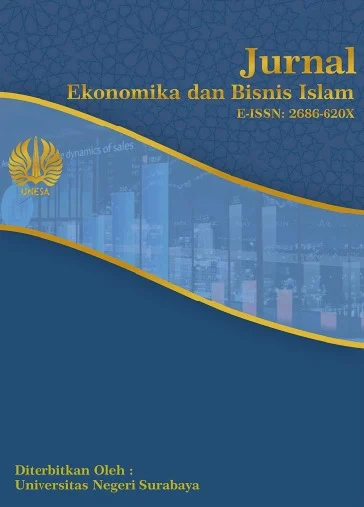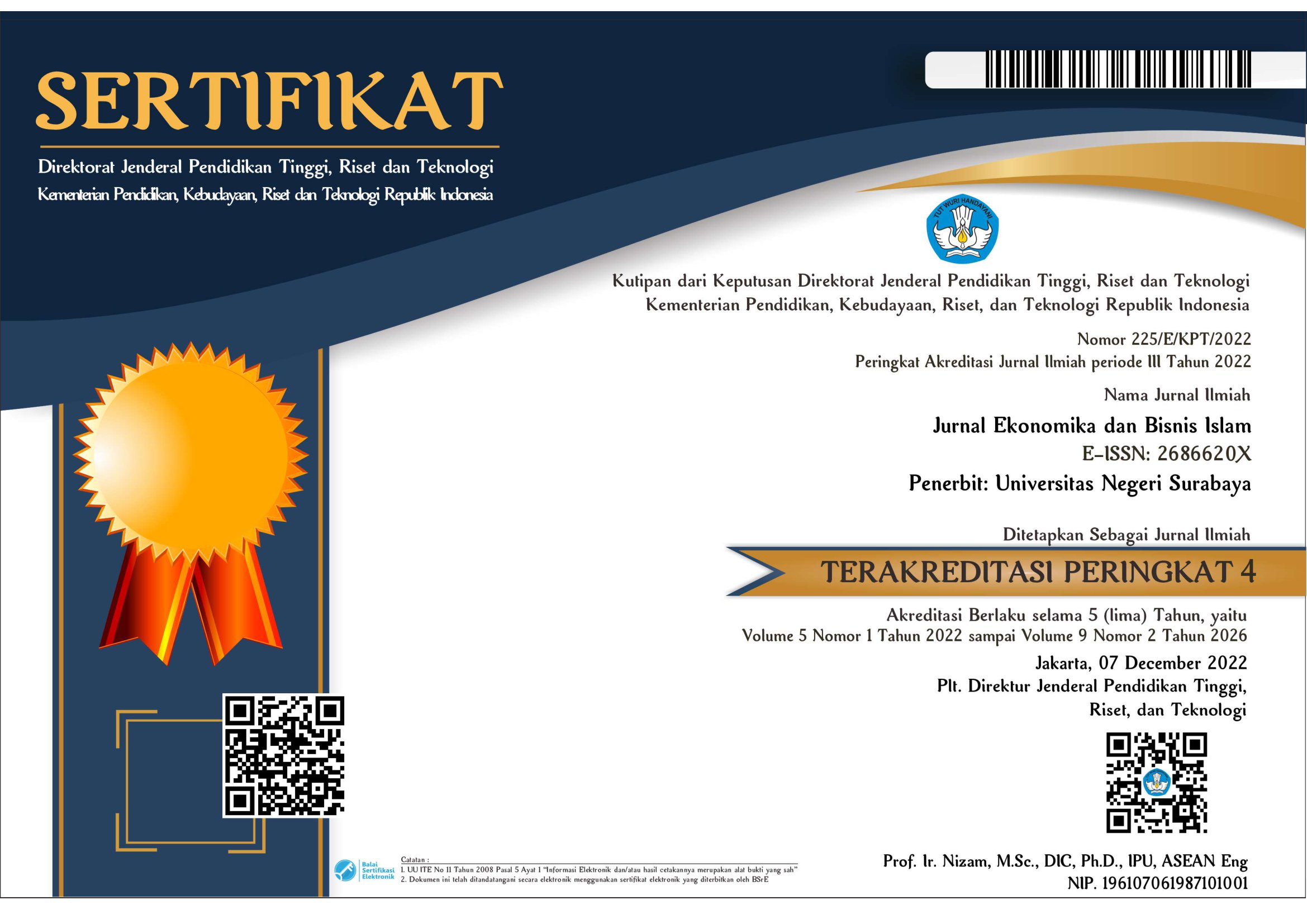Analisis Faktor-Faktor yang Mempengaruhi Minat Deposito Mudharabah di Bank Syariah Indonesia (BSI) di Jawa Timur
DOI:
https://doi.org/10.26740/jekobi.v8n2.p1-19Keywords:
Deposito mudharabah BSI; Attitude toward behavior; Subjective norm; Perceived behavioral control; Religiusitas; Persepsi risikoAbstract
Islamic banking in Indonesia, especially in East Java, has enormous potential due to the dominant Muslim population that can contribute significantly to the regional economy. However, the level of public participation in using Islamic banking services, especially mudharabah savings, remains low. Therefore, an in-depth study is needed to understand the factors that influence the decision to choose mudharabah deposits in Bank Syariah Indonesia. The purpose of this study is to analyze the factors that can influence the interest of the people of East Java in using mudharabah deposits at Bank Syariah Indonesia (BSI). The method used is a quantitative approach with SEM-PLS analysis. Data was obtained through questionnaires distributed to the people of East Java, resulting in 289 samples for analysis. The results of the analysis indicate that interest in BSI mudharabah deposits is significantly influenced by the variables of attitude toward behavior, religiosity, and risk perception. On the other hand, the variables of subjective norm and perceived behavioral control have not been able to exert a significant influence on interest in BSI mudharabah deposits.
References
Abdul Aziz. (2025). Pengkajian Kebiasaan Konsumen Muslim Terhadap Niat Menggunakan Produk Perbankan Syariah di Kabupaten Bogor. El-Mal: Jurnal Kajian Ekonomi & Bisnis Islam, 6(1), 434 –. DOI : https://doi.org/10.47467/elmal.v6i1.6344.
Abdullah, S. N., Hassan, S. H., & Masron, T. A. (2016). Switching Intention Of Muslim Depositors In Islamic Deposit Account. International Journal of Economics, Management and Accounting, 24(1), 83–106. DOI : https://doi.org/10.31436/ijema.v24i1.394.
Adriansyah, L. R., & As-Salafiyah, A. (2025). Mataram mosques management: intention to place mosque funds in Islamic banks. Journal of Islamic Accounting and Business Research, 16(5), 915-936. http://dx.doi.org/10.1108/JIABR-12-2022-0330
Ajzen, I., & Cote, N. G. (2008). Attitudes and the Prediction of Behaviour. In W. D. Crano, & R. Prislin (Eds.). Attitudes and Attitude Change (pp. 289-311). Psychology Press.
Ajzen, I. (1991). The Theory of planned behavior. Organizational Behavior and Human Decision Processes. DOI : https://psycnet.apa.org/doi/10.1016/0749-5978(91)90020-T
Ajzen, I. (2002). Perceived behavioral control, self‐efficacy, locus of control, and the theory of planned behavior 1. Journal of applied social psychology, 32(4), 665-683. DOI : https://psycnet.apa.org/doi/10.1111/j.1559-1816.2002.tb00236.x
Ajzen, I. (2005). The Theory of Planned Behavior. Organizational Behavior and Human Decision Processes. Vol. 50, h.179-211. http://dx.doi.org/10.1016/0749-5978(91)90020-T
Andrianto & Firmansyah, A., (2019). Manajemen Bank Syariah (Implementasi Teori dan Praktek). Surabaya: Qiara Media.
Allah Pitchay, A. B., Mohd Thas Thaker, M. A. B., Azhar, Z., Mydin, A. A., & Mohd Thas Thaker, H. B. (2020). Factors persuade individuals’ behavioral intention to opt for Islamic bank services: Malaysian depositors’ perspective. Journal of Islamic Marketing, 11(1), 234-250. http://dx.doi.org/10.1108/JIMA-02-2018-0029
Amanda, F. A., Yafiz, M., & Anggraini, T. (2024). Pengaruh Tingkat Bagi Hasil, Financing To Deposit Ratio (Fdr) Dan Inflasi Terhadap Deposito Mudharabah Perbankan Syariah. Jurnal Tabarru': Islamic Banking and Finance, 7(1), 42-53. https://doi.org/10.25299/jtb.2024.vol7(1).16318
Andrianto & Firmansyah, A., (2019). Manajemen Bank Syariah (Implementasi Teori dan Praktek). Surabaya: Qiara Media.
Andriyani, A. D., Saputra, D., Mahabbah, H. I. N., Hardi, I., & Hemawan, M. A. F. (2024, July). The Effects of Personal Motivations, Islamic Economic Law, and Perceived Behavioral Control on Gifting Behaviour for Z Generations in TikTok's Live Streaming. In Proceedings of International Conference on Economics Business and Government Challenges (Vol. 7, No. 1, pp. 83-94). https://doi.org/10.33005/icebgc.v7i1.110
Aulia, R., & Wazdi, A. I. (2022). Pengaruh Persepsi Teknologi Informasi, Risiko dan Handling Complaint terhadap Minat Nasabah dalam Menggunakan Internet Banking di Bank BSI KC Suniaraja Bandung. Jurnal Dimamu, 1(3), 285-294. https://doi.org/10.32627/dimamu.v1i3.593
Azhara, R., & Rozza, S. (2024, November). Pengaruh Persepsi Risiko, Persepsi Keamanan, dan User Experience Terhadap Loyalitas Nasabah Menggunakan Aplikasi BSI Mobile. In Seminar Nasional Akuntansi dan Manajemen PNJ (Vol. 5, No. 1).
Cohen, J. (1988). The effect size. Statistical power analysis for the behavioral sciences. Abingdon: Routledge, 77-83.
Fernander, Anita & Wilson, John & Staton, Michele & Leukefeld, Carl. (2006). Exploring the Type-of-Crime Hypothesis, Religiosity, and Spirituality in an Adult Male Prison Population. International journal of offender therapy and comparative criminology. 49. 682-95. 10.1177/0306624X05274897. DOI : https://doi.org/10.1177/0306624x05274897
Hair, J.F., Risher, J.J., Sarstedt, M. and Ringle, C.M. (2019) When to Use and How to Report the Results of PLS-SEM. European Business Review, 31, 2-24. https://doi.org/10.1108/EBR-11-2018-0203
Handayani, A., Azman, H. A., & Ismail, I. (2019). Pengaruh Pengetahuan Dan Sikap Terhadap Perilaku Memilih Bank Syariah Dengan Faktor Religiusitas Sebagai Moderating Variable. EKONOMIKA SYARIAH: Journal of Economic Studies, 3(1), 1-19. DOI : https://doi.org/10.30983/es.v3i1.934
Ibrahim, Y. (2022). Bank Syariah dan Bank Konvensional:(Suatu Analisis Perbedaan dan Prinsip-Prinsipnya). Syarah: Jurnal Hukum Islam & Ekonomi, 11(1), 1-15. DOI : https://doi.org/10.47766/syarah.v11i1.293
Ibrahim, Z. (2015). Kontribusi Perbankan Syariah Terhadap Perekonomian Banten. ISLAMICONOMIC: Jurnal Ekonomi Islam, 6(1). DOI : https://doi.org/10.32678/ijei.v6i1.32
Islamuddin H. (2012). Psikologi Pendidikan. Yogyakarta: Pustaka Belajar.
Jawad, D., & Larbi, T. (2023). Risk Perception And Investment Intention In Islamic Banks'term Deposits: An Empirical Study In Morocco. European Journal of Economic and Financial Research, 7(4). DOI : http://dx.doi.org/10.46827/ejefr.v7i4.1571
Kaakeh, A., Hassan, M.K. and Van Hemmen Almazor, S.F. (2019), “Factors affecting customers’ attitude towards Islamic banking in UAE”, International Journal of Emerging Markets, Vol. 14 No. 4, pp. 668-688. DOI : https://doi-org.unesalibrary.remotexs.co/10.1108/IJOEM-11-2017-0502
Karnaen, A.P., & Antonio, M.S., 1992. Apa dan Bagaimana Bank Islam, Yogyakarta: Dana Bhakti Wakaf.
Khairunnisa, I. A., & Cahyono, H. (2020). Hubungan pengetahuan, religiusitas, dan lingkungan sosial terhadap minat menabung menggunakan bank syariah. Jurnal Ekonomika Dan Bisnis Islam, 3(3), 1-14. DOI : https://doi.org/10.26740/jekobi.v3n3.p1-14/
Lestari, I. D., Febriani, H. P., Baharuddin, J., & Affandy, F. F. (2023). Interest in Saving Students at Sharia Banks in Jayapura City, Papua Province. AL-ARBAH: Journal of Islamic Finance and Banking, 5(1), 23-32. DOI : https://doi.org/10.21580/al-arbah.2023.5.1.17966
Lujja, S., Omar Mohammad, M., & Hassan, R. (2016). Modelling public behavioral intention to adopt Islamic banking in Uganda: the theory of reasoned action. International Journal of Islamic and Middle Eastern Finance and Management, 9(4), 583-600. DOI : http://dx.doi.org/10.1108/IMEFM-08-2015-0092
Machrus, H., & Purwono, U. “Pengukuran Perilaku berdasarkan theory of Planned Behavior”. Jurnal INSAN, Vol. 12, no 1 (2010). DOI : https://doi.org/10.14421/jpsi.v9i1.2087
Masoud, M. A. 2013. The Effect of Perceived Risk on Online Shopping in Jordan. European Journal of Business and Management, 5 (6).
Maulana, H., Razak, D. A., & Adeyemi, A. A. (2018). Factors influencing behaviour to participate in Islamic microfinance. International Journal of Islamic and Middle Eastern Finance and Management, 11(1), 109-130. DOI : https://doi-org.unesalibrary.remotexs.co/10.1108/IMEFM-05-2017-0134
Noegroho, I. (2017). Merger Merupakan tantangan atau peluang bagi perekonomian Indonesia. Jurnal Penelitian Ekonomi dan Akuntansi, 2(3), 12-Halaman. DOI : https://doi.org/10.30736/jpensi.v2i3.107
Padungraksart, A., Nazjmi, W., & Fisol, M. (2021). Investing towards Shari’ah compliant public equity funds products: Using planned behavior theory (TPB). International Journal of Academic Research in Business and Social Sciences, 1(6), 793-803. DOI : http://dx.doi.org/10.6007/IJARBSS/v11-i6/10208
Palm, R. (1999). Perceived risk and the earthquake insurance purchase decision: a commentary on a paper by Lennart Sjöberg. Journal of Risk Research, 2(4), 289–294. DOI : http://dx.doi.org/10.1080/136698799376736
Prastiwi, I. E., & Zuhdi, M. N. (2022). Analysis of Factors Affecting Interest in Saving in Islamic Bank: Knowledge, Social Environment and Psychological Factors. International Journal of Economics, Business and Accounting Research (IJEBAR), 6(2), 1113-1122. DOI : https://doi.org/10.29040/ijebar.v6i2.4777
Priyadi, R., Ismal, R., & Rahman, A. (2024). Does Intention Matter For Bmt’s Members To Invest In Mudharabah Muqayyadah Deposit? The Case of BMT under Indonesia Sharia Cooperative Association (AKSYINDO). Airlangga International Journal of Islamic Economics & Finance, 7(1). DOI : http://dx.doi.org/10.20473/aijief.v7i01.58237
Rhoudri, S., & Benazzou, L. (2024). Adoption patterns of profit-sharing based deposits: empirical evidence from a Muslim majority country. Journal of Islamic Marketing, 15(12), 3484-3514. DOI : https://doi.org/10.1108/JIMA-05-2023-0163
Richard Robbins, Religion and Society in Tension. By Charles Y. Glock and Rodney Stark. Chicago: Rand McNally and Company, 1965. Pp. xii, 306. No price indicated, Sociology of Religion, Volume 27, Issue 3, Fall 1966, Pages 173–175. DOI : https://doi.org/10.2307/3710391
Rizal Ula Ananta Fauzi, Dian Cita Ningtiyas Ari Kadi, & Arman Hj. Ahmad. (2021). The Role of Trust as Mediator in the Effect of Religiosity and Bank Image towards Consumers’ Intention: : An Empirical Case Study of Bank Muamalat, Indonesia. Asia Pacific Journal of Social Science Research, 6(1), 22. DOI : https://doi.org/10.37263/apjssr.v6i1.114
Sakti, R. A. (2020). Pengaruh perilaku, norma subjektif, dan kontrol perilaku terhadap minat nasabah memilih produk tabungan iB amanah di bank NTB syariah. Schemata: Jurnal Pasca Sarjana IAIN Mataram, 9(1), 87-102. DOI : https://doi.org/10.20414/schemata.v9i1.1930
Sarstedt, M., Hair, J. F., Pick, M., Liengaard, B. D., Radomir, L., & Ringle, C. M. (2022). Progress in partial least squares structural equation modeling use in marketing research in the last decade. Psychology & Marketing, 39(5), 1035-1064. DOI : https://doi.org/10.1002/mar.21640
Setiawan, F., & Aini, L. N. (2023). Literasi Keuangan Syariah dan Preferensi Warga Pinggiran Kota terhadap Lembaga Keuangan Syariah. Brilliant: Journal of Islamic Economics and Finance, 1(1), 31-53.
Shith, M. S. S. P. M., Safruddin, M., Rahim, M. A., & Putera, N. S. F. M. S. (2021). Using the theory of planned behavior and religion to assess customers behavioral intention to adopt Islamic banking services in Malaysia. Jurnal Islam Dan Masyarakat Kontemporari, 22(2), 36-45. DOI : https://doi.org/10.37231/jimk.2021.22.2.575
Stone, R.N. and Grønhaug, K. (1993), "Perceived Risk: Further Considerations for the Marketing Discipline", European Journal of Marketing, Vol. 27 No. 3, pp. 39-50. DOI : https://doi.org/10.1108/03090569310026637
Sudarsono, H., (2015). Bank Dan Lembaga Keuangan Syariah: Deskripsi Dan Ilustrasi. 4th ed. yogyakarta: ekonisia.
Suharyat, Y. (2009). Hubungan antara sikap, minat dan perilaku manusia. Jurnal region, 1(3), 1-19.
Syahrum, & Salim. (2014). Metodologi Penelitian Kuantitatif. Citapustaka Media.
T, T. (2017). Perilaku Konsumsi Upaya Meningkatkan Potensi Produk Deposito di Bank Syariah. Islamadina : Jurnal Pemikiran Islam, 18(1), 21–36. https://doi.org/10.30595/islamadina.v0i0.1527
Trimulato, T. (2015). Pengembangan produk bank syariah melalui investasi mudharabah dengan bagi hasil yang pasti. Jurnal Akuntansi Dan Bisnis, 15(2), 74-87. DOI : http://dx.doi.org/10.20961/jab.v15i2.178
Sugiyono. (2019). Metode Penelitian Kuantitatif, Kualitatif, dan R&D. Bandung: Alfabeta.
Wati, R. P. A., & Haris, H. (2024). Decomposed theory of planned behavior minat mahasiswa dalam menggunakan BSI Mobile. Jurnal Global Ilmiah, 1(5), 310-320. DOI : https://doi.org/10.55324/jgi.v1i5.46
Yani, S., Usdeldi, U., & Ridho, T. (2024). Pengaruh Kemanfaatan, Kemudahan Penggunaan, dan Risiko Terhadap Minat Penggunaan BSI Mobile (Studi Pada Mahasiswa Fakultas Ekonomi dan Bisnis Islam). ECo-Fin, 6(2), 341-349. DOI : https://doi.org/10.32877/ef.v6i2.1307
Downloads
Published
How to Cite
Issue
Section
License
Copyright (c) 2025 Akhlis Fatikhul Islam, Ach Yasin

This work is licensed under a Creative Commons Attribution 4.0 International License.
This work is licensed under a Creative Commons Attribution 4.0 International License.
 Abstract views: 282
,
Abstract views: 282
, PDF Downloads: 198
PDF Downloads: 198














